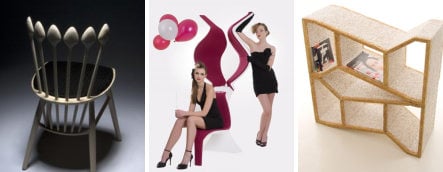From lamps made out of zippers to chairs fashioned out of spoons, the products on display at the Stockholm Furniture Fair’s Greenhouse – a platform for freelance and student designers – showed creative and playful use of materials, as well as an interdisciplinary approach to design.
Several of the young exhibitors seem to have caught a wave of nostalgia, including Fredrik Färg, a recent graduate of the School of Design and Crafts (HDK) at the University of Gothenburg. Promoting the idea of “slow fashion furniture”, his RE:cover collection is inspired by classic menswear. Färg uses old chairs and replaces the backrests with mouldable polyester felt that becomes a supporting structure when baked in a big oven. The foldable backrest on his “Coat” chair, for instance, resembles the collar on a men’s jacket.
Like Färg, Maria Sandberg explores timelessness with Family Tree, a “contemporary interpretation of the patchwork quilt,” which was part of HDK’s “Beautiful Death” exhibition. With the middle section made out of remnants from a textile factory, bits of personal fabric can be placed along the edges of the quilt.
With “Coffee ceremony,” Martin Horgan is another designer who advocates slowing things down. Rather than a single surface, the table has five smaller trays that are only big enough for a glass or cup. There isn’t enough room for a laptop, and the design encourages people to concentrate on the coffee and conversation.
But while some promote slow and nostalgic design, others work according to a “speed furniture concept.” Israeli design studio Godspeed, for example, makes furniture out of waste wood repurposed from the many traditional carpenters in their Tel Aviv neighborhood within a time limit of one hour. The result isn’t always pretty, but it does show how material can be reused in an interesting and functional way.
Reuse and recycling are also recurrent themes throughout Ung 7, an annual juried, travelling exhibition open to young designers, either Swedish or working in Sweden. “Decades”, a chest by Anna Irinarchos and Lisa Widén of WIS Design, is made of old drawers the pair found at flea markets. Another example is “Keep”, by Petter Thörne and Anders Johnsson, a table made out of waste material from a furniture factory and bound together without glue using leftover metal strapping from timber deliveries.
Designers such as Emma Marga Blanche, a French woman based in Stockholm, also remind us of the importance of fun. Her products include a “magic folding candlestick”, a half umbrella lamp and a portable picnic stool remade from old baskets. With a similar sense of whimsy, Erika Lövquist’s Water Lily is a ceiling lamp that reaches the floor. Other examples of impish design are the work of Jonas Wagell, whose Symbio lamp and Bold wall clock bring nothing but smiles, and Smånsk’s Neo Rococo chest of drawers.
As in previous years, the Greenhouse broke the monotony of the Stockholm Furniture Fair, where really interesting commercial products are hard to find. If this year’s crop of young designers says anything about the future, it’s time to sit back and enjoy Swedish design.
See also: Furniture Fair Photo Gallery



 Please whitelist us to continue reading.
Please whitelist us to continue reading.